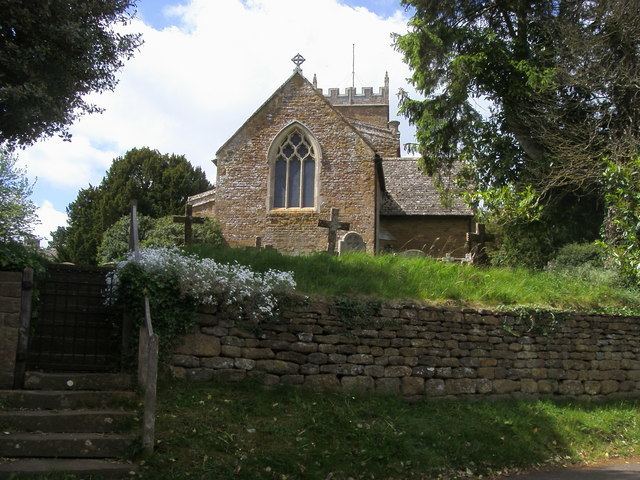OS grid reference SP3742 Local time Saturday 7:18 AM | Sovereign state United Kingdom Postcode district OX15 Dialling code 01295 | |
 | ||
Weather 8°C, Wind S at 19 km/h, 85% Humidity | ||
Shenington is a village about 5 miles (8 km) west of Banbury. It was an exclave of Gloucestershire until the Counties (Detached Parts) Act 1844 transferred it to Oxfordshire. Shenington is on Oxfordshire's boundary with Warwickshire.
Contents
- Map of Shenington Banbury UK
- Manor
- Parish church
- Social and economic history
- RAF Edgehill
- Amenities
- References
Map of Shenington, Banbury, UK
Manor
By the 11th century Shenington was part of the lordship of Tewkesbury in Gloucestershire. Prior to the Norman Conquest of England the manor was held by the great Saxon thegn Brictric son of Algar. After the Norman Conquest Brictric's lands, including Shenington, were granted to Queen Matilda. When she died in 1083 her husband William the Conqueror inherited her estates, and the Domesday Book records that in 1086 Robert D'Oyly was farming Shenington for the King. In about 1087 William II granted the honour of Gloucester, including Shenington, to a Norman baron called Robert Fitzhamon. In 1194 Shenington was amongst lands confiscated for the Crown after Prince John's attempted overthrow of Richard. After 1197 Shenington was again included with Gloucester in lands that King John granted to the 1st Earl of Gloucester. When the 4th Earl of Gloucester was killed at the Battle of Bannockburn in 1314, Shenington was divided between two of his sisters, Margaret de Clare and Eleanor de Clare.
Margaret, widow of Piers Gaveston received three fifths of the manor of Shenington. In 1317 Hugh de Audley, 1st Earl of Gloucester became Margaret's second husband, and on Audley's death in 1347 their estates passed to their son-in-law Ralph Stafford, 1st Earl of Stafford. This part of Shenington remained with the Staffords until at least 1460, when it was among the possessions of Humphrey Stafford, 1st Duke of Buckingham.
Eleanor, wife of Hugh Despenser the Younger received the remaining two fifths of Shenington. This part of Shenington remained with their heirs until at least 1420, when part of it was held by Richard de Beauchamp, 1st Earl of Worcester, son-in-law of Isabel le Despenser, Countess of Worcester and Warwick.
Parish church
The Church of England parish church of the Holy Trinity was in existence by the first quarter of the 12th century. The Norman chancel arch survives from this period, but when the Gothic Revival architect J.L. Pearson restored the church in 1879 he built a new chancel arch and moved the Norman one to the north side of the chancel. In the 13th century the south aisle was added, linked with the nave by an arcade in the Early English style. Early in the 14th century the south aisle was rebuilt and new windows inserted in the chancel, all in the Decorated Gothic style. The Perpendicular Gothic bell tower was built in 1504. The south porch is also a Perpendicular Gothic addition. The tower has a ring of five bells cast in 1678 by Henry Bagley of Chacombe and a clock that was installed before 1720. Holy Trinity is now one of eight ecclesiastical parishes in the Ironstone Benefice.
Social and economic history
On 3 December 1810 a bare-knuckle boxing match was staged at Shenington Hollow, exploiting the parish's inaccessibility from Gloucestershire's Justices of the Peace. The pugilists were British champion Tom Cribb and Virginian former slave Tom Molineaux. Cribb's victory made him World champion.
In 1868 the National Gazetteer of Great Britain and Ireland described Shenington:
"...a parish in the upper division of Tewkesbury hundred, county Oxford, formerly in, Gloucestershire, 6 miles N.W. of Banbury, its post town, and 29 N.W. of Oxford. The village, which is situated on the borders of Warwickshire and Gloucestershire, is wholly agricultural. The surface is hilly, and the land chiefly arable. The soil produces good crops of wheat, barley, and turnips. The living is a rectory in the diocese of Worcester, value £321. The church, dedicated to the Holy Trinity, was partially rebuilt in the last century. The parochial charities produce about £6 per annum. The Dissenters have a place of worship. There is a free school."A National School was operating in Shenington by 1868 and a school building for it was completed in 1871. The building was enlarged in 1905 to absorb the children of neighbouring Alkerton, whose own National School was closed that year. By 1962 Shenington school was a Church of England school. At some point it must have been reorganised as a junior school, as it is now a primary school.
RAF Edgehill
In the Second World War RAF Edgehill was used for flight tests of experimental jet aircraft. After the war it was decommissioned from RAF use and became Shenington Airfield. Shenington Gliding Club is based here. Part of the former RAF air station is now Shenington Kart Track, the home of Shenington Kart Racing Club. Shenington KRC was founded in 1959 and is the oldest Kart racing club in the UK. Shenington Kart circuit also hosts Pedal Car Racing and has staged a 24-hour pedal car race since 2008.
Amenities
Shenington has one public house, The Bell.
